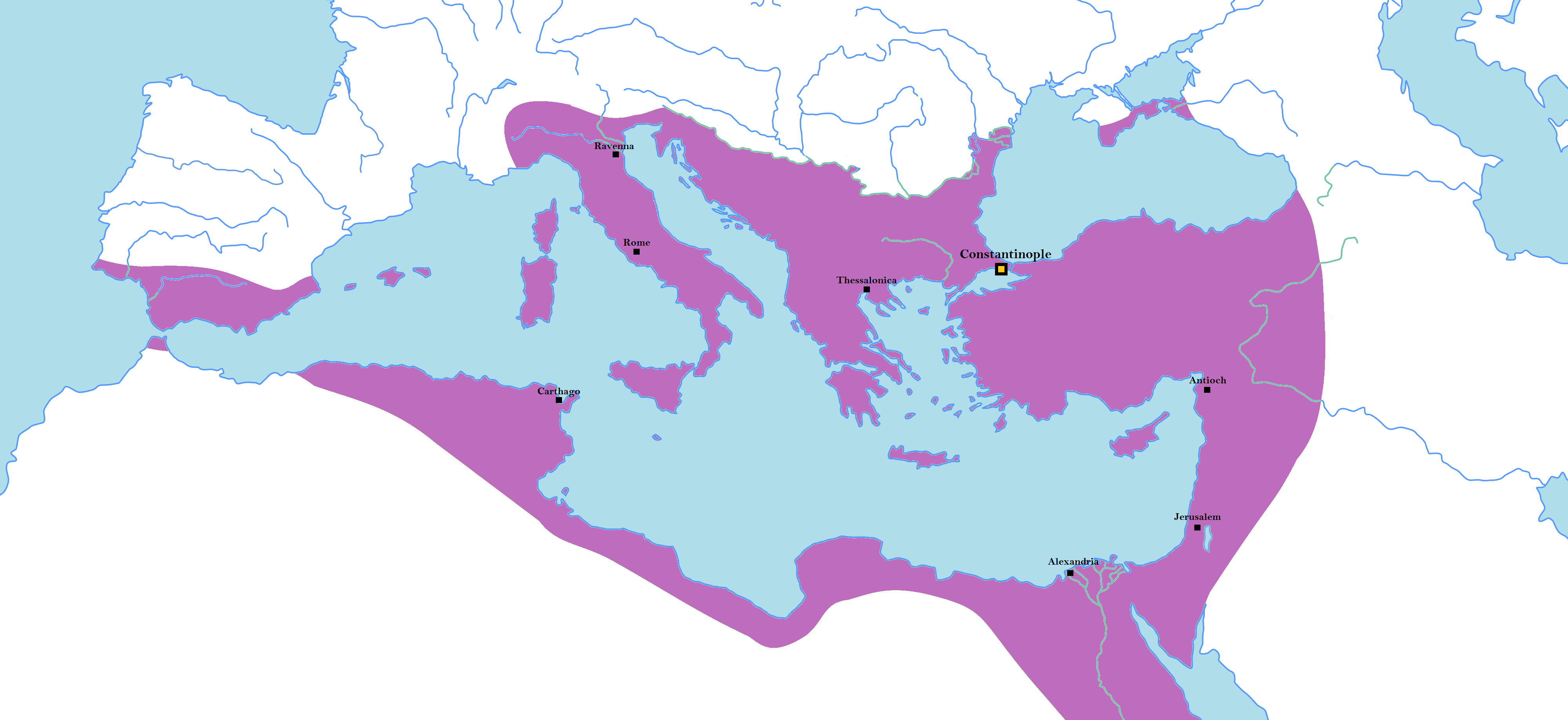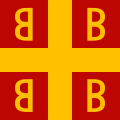More languages
More actions
No edit summary Tag: Visual edit |
(→Stagnation and decline: more accurate) Tag: Visual edit |
||
| (6 intermediate revisions by 4 users not shown) | |||
| Line 1: | Line 1: | ||
{{DISPLAYTITLE:Roman Empire (395–1453)}} | {{DISPLAYTITLE:Roman Empire (395–1453)}} | ||
{{Infobox country|name= | {{Infobox country|name=Roman Empire|native_name=Βασιλεία Ῥωμαίων<br>Imperium Romanum|image_flag=Byzantine imperial flag.png|year_start=395|year_end=1453|image_map=Byzantine Empire 555 CE.png|map_width=290|map_caption=Byzantium at its maximum extent in 555CE|capital=[[Constantinople]]|common_languages=Greek|mode_of_production=[[Feudalism]]|government_type=Absolute monarchy|established_event1=Formation of the Roman Empire|date_start=|established_date1=27 BCE|established_event2=Change of the capital from Rome to Constantinople|established_date2=330|event_pre=East-West division|date_pre=|event_start=Final division of the Roman Empire|event_end=Constantinople falls; Byzantium ends|date_end=|population_estimate=~26,000,000|population_estimate_year=565 CE}} | ||
'''Byzantium''', also called the '''Byzantine Empire''' or the '''Eastern Roman Empire''', was | '''Byzantium''', also called the '''Byzantine Empire''' or the '''Eastern Roman Empire''', was [[Hellenic Republic|Greco]][[Roman Empire (27 BCE–395 CE)|-Roman]] state that lasted from 395 to 1453 CE. It is commonly viewed as a medieval continuation of the [[Roman Empire (27 BCE–395 CE)|Roman Empire]]. At its foundation, the Byzantine Empire controlled one-third of the Roman army but collected two-thirds of its tax revenue. Its well-equipped, professional armies were able to defeat repeated invasions while the western empire collapsed into a patchwork of warring states.<ref name=":0222">{{Citation|author=Neil Faulkner|year=2013|title=A Marxist History of the World: From Neanderthals to Neoliberals|chapter=European Feudalism|page=79|pdf=https://cloudflare-ipfs.com/ipfs/bafykbzacedljwr5izotdclz23o3c5p4di4t3ero3ncbfytip55slhiz4otuls?filename=Neil%20Faulkner%20-%20A%20Marxist%20History%20of%20the%20World_%20From%20Neanderthals%20to%20Neoliberals-Pluto%20Press%20%282013%29.pdf|publisher=Pluto Press|isbn=9781849648639|lg=https://libgen.rs/book/index.php?md5=91CA6C708BFE15444FE27899217FBA8E}}</ref> | ||
Byzantium's [[Conservatism|conservative]] | Byzantium's [[Conservatism|conservative]] ruling class prevented technological advancement and relied on knowledge dating to the Roman era in the fields of architecture, metallurgy, and military strategy.<ref name=":0">{{Citation|author=Chris Harman|year=1999|title=A People's History of the World|page=117–120|chapter=The ‘Middle Ages’|isbn=9781898876557|city=London|publisher=Bookmarks Publications Ltd|lg=https://libgen.rs/book/index.php?md5=F247C9051030CCBA52C1E5A4468834E9|pdf=https://cloudflare-ipfs.com/ipfs/bafykbzacea6om2gf2ixovddv7moyuv3i4rj2ggii7gta4x4h4rk4ebpqdvd6i?filename=Chris%20Harman%20-%20A%20People%27s%20History%20of%20the%20World.pdf}}</ref> | ||
== History == | == History == | ||
=== Pre-Division === | |||
In 324, construction of Constantinople started. In 330, Constantinople became the capital. | |||
=== Early history === | === Early history === | ||
Early Byzantine emperors were able to keep control of the [[Balkans]], [[Syria]], Anatolia, and [[Egypt]]. Barely 50 years after [[Justinian I|Justinian]]'s last attempt to conquer the west, Byzantium lost economic control of its outer territories and reoriented its economy around defense.<ref name=":0" /> | Early Byzantine emperors were able to keep control of the [[Balkans]], [[Syria]], Anatolia, and [[Egypt]]. Barely 50 years after [[Justinian I|Justinian]]'s last attempt to conquer the west, Byzantium lost economic control of its outer territories and reoriented its economy around defense.<ref name=":0" /> | ||
=== | === Stagnation and decline === | ||
The Arabs took control of [[Syria]] in 636 at the Battle of Yarmuk. When the Turks seized eastern Anatolia in 1071, the empire shrank to half its | The Arabs took control of [[Syria]] in 636 at the Battle of Yarmuk and would conquer the wealthy grain-producing regions of Egypt and North Africa in the following decades. When the Turks seized eastern Anatolia in 1071, the empire shrank to half its territory during 1025. Crusaders sacked the capital city of Constantinople in 1204 during the [[Fourth Crusade]], establishing the [[Latin Empire]]. Although the Byzantine rump-state of Nicaea would restore the empire in 1261, the Byzantines were never able to fully recover and the remnants of the empire finally fell to the [[Ottoman Empire|Ottomans]] in 1453.<ref name=":0222" /> | ||
== Economy == | |||
Although the empire was well-developed and wealthy compared to surrounding realms, its extensive imperial bureaucracy prevented the growth of a strong mercantile class, allowing for Western merchants to eventually gain large amounts of economic influence.<ref name=":0" /> | |||
== Culture and society == | |||
== Religion == | === Religion === | ||
Byzantine authorities persecuted [[Paganism|pagans]], [[Judaism|Jews]], and non-Orthodox [[Christianity|Christians]], who together made up almost half of the total population.<ref name=":0" /> | Byzantine authorities persecuted [[Paganism|pagans]], [[Judaism|Jews]], and non-[[Orthodox Christianity|Orthodox]] [[Christianity|Christians]], who together made up almost half of the total population.<ref name=":0" /> | ||
== References == | == References == | ||
[[Category:Stubs]] | [[Category:Stubs]] | ||
[[Category:Medieval history]] | [[Category:Medieval history]] | ||
Latest revision as of 19:20, 5 March 2024
| Roman Empire Βασιλεία Ῥωμαίων Imperium Romanum | |
|---|---|
| 395–1453 | |
|
Flag | |
 Byzantium at its maximum extent in 555CE | |
| Capital | Constantinople |
| Common languages | Greek |
| Dominant mode of production | Feudalism |
| Government | Absolute monarchy |
| History | |
• Formation of the Roman Empire | 27 BCE |
• Change of the capital from Rome to Constantinople | 330 |
• Final division of the Roman Empire | 395 |
• Constantinople falls; Byzantium ends | 1453 |
| Population | |
• 565 CE estimate | ~26,000,000 |
Byzantium, also called the Byzantine Empire or the Eastern Roman Empire, was Greco-Roman state that lasted from 395 to 1453 CE. It is commonly viewed as a medieval continuation of the Roman Empire. At its foundation, the Byzantine Empire controlled one-third of the Roman army but collected two-thirds of its tax revenue. Its well-equipped, professional armies were able to defeat repeated invasions while the western empire collapsed into a patchwork of warring states.[1]
Byzantium's conservative ruling class prevented technological advancement and relied on knowledge dating to the Roman era in the fields of architecture, metallurgy, and military strategy.[2]
History[edit | edit source]
Pre-Division[edit | edit source]
In 324, construction of Constantinople started. In 330, Constantinople became the capital.
Early history[edit | edit source]
Early Byzantine emperors were able to keep control of the Balkans, Syria, Anatolia, and Egypt. Barely 50 years after Justinian's last attempt to conquer the west, Byzantium lost economic control of its outer territories and reoriented its economy around defense.[2]
Stagnation and decline[edit | edit source]
The Arabs took control of Syria in 636 at the Battle of Yarmuk and would conquer the wealthy grain-producing regions of Egypt and North Africa in the following decades. When the Turks seized eastern Anatolia in 1071, the empire shrank to half its territory during 1025. Crusaders sacked the capital city of Constantinople in 1204 during the Fourth Crusade, establishing the Latin Empire. Although the Byzantine rump-state of Nicaea would restore the empire in 1261, the Byzantines were never able to fully recover and the remnants of the empire finally fell to the Ottomans in 1453.[1]
Economy[edit | edit source]
Although the empire was well-developed and wealthy compared to surrounding realms, its extensive imperial bureaucracy prevented the growth of a strong mercantile class, allowing for Western merchants to eventually gain large amounts of economic influence.[2]
Culture and society[edit | edit source]
Religion[edit | edit source]
Byzantine authorities persecuted pagans, Jews, and non-Orthodox Christians, who together made up almost half of the total population.[2]
References[edit | edit source]
- ↑ 1.0 1.1 Neil Faulkner (2013). A Marxist History of the World: From Neanderthals to Neoliberals: 'European Feudalism' (p. 79). [PDF] Pluto Press. ISBN 9781849648639 [LG]
- ↑ 2.0 2.1 2.2 2.3 Chris Harman (1999). A People's History of the World: 'The ‘Middle Ages’' (pp. 117–120). [PDF] London: Bookmarks Publications Ltd. ISBN 9781898876557 [LG]

